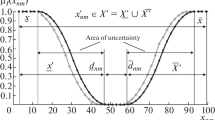Abstract
In real systems, fault diagnosis is performed by a human diagnostician, and it encounters complex knowledge associations, both for normal and faulty behaviour of the target system. The human diagnostician relies on deep knowledge about the structure and the behaviour of the system, along with shallow knowledge on fault-to-manifestation patterns acquired from practice. This paper proposes a general approach to embed deep and shallow knowledge in neural network models for fault diagnosis by abduction, using neural sites for logical aggregation of manifestations and faults. All types of abduction problems were considered. The abduction proceeds by plausibility and relevance criteria multiply applied. The neural network implements plausibility by feed-forward links between manifestations and faults, and relevance by competition links between faults. Abduction by plausibility and relevance is also used for decision on the next best test along the diagnostic refinement. A case study on an installation in a rolling mill plant is presented.







Similar content being viewed by others
References
Ariton V (2003) Deep and shallow knowledge in fault diagnosis. In: Palade V et al (eds) Proceedings of KES2003—the 7th international conference on knowledge-based intelligent engineering and information systems, Oxford, 3–5 September 2003, Lecture Notes in Artificial Intelligence, LNAI 2773, Springer, Berlin Heidelberg New York pp 748–755
Ariton V, Baciu C (2002) Knowledge elicitation and case tool for fault diagnosis in multifunctional conductive flow systems. In: Proceedings of SCI2002—6th world multiconference on systemics, cybernetics and informatics, Orlando-Florida, 14–18 July 2002, vol XXII, pp 345–350
Ariton V (2001) Abstraction 7*levels for the fault isolation in multifunctional conductive flow systems. In: Proceedings of LSS2001—the 9th IFAC/IFORS/IMACS/IFIP/symposium on large scale systems: theory and applications, 18–20 July 2001, Bucharest, pp 386–391
Ariton V, Ariton D (2000) A general approach for diagnostic problems solving by abduction. In: Proceedings of IFAC-SAFEPROCESS 2000, Budapest, pp 446–451
Ariton V (1999) Semi-qualitative encoding of manifestations at faults in conductive flow systems. In: Proceedings of the international workshop on constructivity, complexity and fuzzy structures—CCF’99, University of Galati, pp 23–28
Ayeb B, Wang S, Ge J (1998) A unified model for abduction-based reasoning. IEEE Trans Syst Man Cybern A Syst Hum 28(4):408–424
Bylander T, Allemang D, Tanner MC, Josephson JR (1991) The computational complexity of abduction. artificial intelligence, vol 49. Elsevier, Amsterdam, pp 25–60
Cherkassky V, Lari-Najafi H (1992) Data representation for diagnostic neural networks. IEEE Expert 7(5):43–53
Colado JMF, Korbicz J, Patan K, Patton RJ, Sa da Costa MG (2001) Soft computing approaches to fault diagnosis for dynamic systems. Eur J Control 7(2–3):248–286
Cordier MO, Dague P, Dumas M, Lévy F, Motmain J, Staroswiecki M, Travé-Massuyès L (2000) AI and automatic control approaches of model-based diagnosis: links and underlying hypotheses. In: Proceedings of IFAC-SAFEPROCESS 2000, Budapest, pp 274–279
Davis R (1993) Retrospective on “diagnostic reasoning based on structure and behavior”, vol 59. Artificial Intelligence, Elsevier, Amsterdam, pp 149–157
De Kleer J, Kurien J (2003) Fundamentals of model-based diagnosis. Proceedings of IFAC-SAFEPROCESS 2003, June 2003, Washington, pp 1–12
Dubois D, Prade H (1998) Possibility theory: qualitative and quantitative aspects. In: Smets P (ed) Handbook of defeasible reasoning and uncertainty management systems, vol 1. Kluwer, Dordrecht, pp 120–159
Konolige K (1992) Abduction versus closure in causal theories, vol 53. Artificial Intelligence, Elsevier, pp 255–272
Kruse R, Gebhardt J, Klawon F (1994) Foundations of fuzzy systems. Willey, New York
Kuipers BJ (1994) Qualitative reasoning: modeling and simulation with incomplete knowledge. MIT Press, Cambridge
Palade V, Patton RJ, Uppal FJ, Quevedo J, Daley S (2002) Fault diagnosis of an industrial gas turbine using neuro-fuzzy methods. In: Proceedings of the 15th IFAC world congress, 21–26 July 2002, Barcelona, pp 2477–2482
Patton RJ, Frank PM, Clark RN (eds) (2000) Issues of fault diagnosis for dynamic systems, Springer, Berlin Heidelberg New York
Peng Y, Reggia J (1990) Abductive inference models for diagnostic problem solving. Springer, Berlin Heidelberg New York
Schurz G (2002) Models of abductive reasoning, TPD preprints, annual 2002, no.1, University of Düsseldorf
Struss P (2003) The discrete charm of diagnosis based on continuous models. In: Proceedings of IFAC-SAFEPROCESS 2003, June 2003, Washington, pp 35–39
Turksen IB (1996) Non-specificity and interval-values fuzzy sets, fuzzy sets and systems, vol 80, pp 87–100
Uppal FJ, Patton RJ, Palade V (2002) Neuro-fuzzy based fault diagnosis applied to an electro-pneumatic valve. In: Proceedings of the 15th IFAC world congress, Barcelona, 21–26 July 2002, pp 2483–2488
Author information
Authors and Affiliations
Corresponding author
Rights and permissions
About this article
Cite this article
Ariton, V., Palade, V. Human-like fault diagnosis using a neural network implementation of plausibility and relevance. Neural Comput & Applic 14, 149–165 (2005). https://doi.org/10.1007/s00521-004-0449-5
Received:
Accepted:
Published:
Issue Date:
DOI: https://doi.org/10.1007/s00521-004-0449-5




